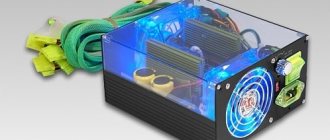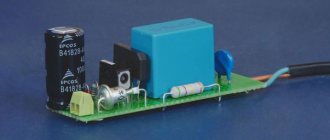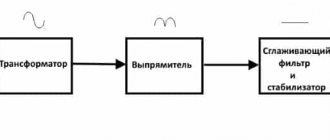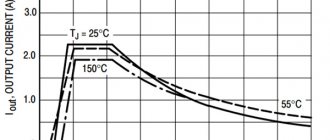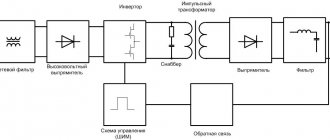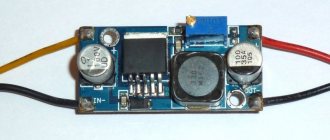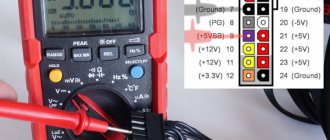Many people quite often confuse power supplies and drivers, connecting LEDs and LED strips from the wrong sources.
As a result, after a short period of time they fail, and you have no idea what the reason was and begin to mistakenly blame the “low-quality” manufacturer.
Let's take a closer look at what their differences are and when you need to use one or another power source. But first, let's briefly look at the types of power supplies.
Transformer block
Today it is quite rare to see the use of a transformer power supply. The scheme of their assembly and operation is quite simple and understandable.
The most important element here is definitely the transformer. At home, it converts 220V voltage into 12 or 24V. That is, there is a direct conversion of one voltage to another.
The network frequency is the usual 50 Hertz.
Next behind it is a rectifier. It rectifies the alternating voltage sinusoid and produces a “constant” voltage at the output. That is, 12V supplied to the consumer is already a constant voltage of 12V, and not alternating.
This scheme has 3 main advantages:
- its simplicity
- simplicity of design
- relative reliability
However, there are also disadvantages here that made the developers think and come up with something more modern.
- firstly, it is heavy and has decent dimensions
- as a consequence of the first drawback - a large consumption of metal for assembling the entire structure
- Well, the whole thing is worsened by low cosine phi and low efficiency
This is why switching power supplies were invented. There is a slightly different operating principle here.
LED strip markings and their differences
One common type of LED lighting is strip lighting. Its power directly depends on how many working diodes are connected to the power supply network. Diodes of different sizes are allowed in production, hence the two categories of tapes:
- SMD 3028;
- SMD 5050.
Now let's look at the decoding of the markings. The numbers 30 and 28, for example, indicate a specific size. That is, the LED size will be 3.0 mm by 2.8 mm. In the case of the 5050, the size will be 5.0 by 5.0 millimeters. Tapes marked SMD 3028 can contain 60, 120 and 240 light diodes. SMD 5050 tape can accommodate 30, 60 and 120 diodes.
Switching power supplies
Firstly, voltage rectification occurs immediately. That is, AC 220V is supplied to the input and immediately converted to DC 220V at the input.
Next is the pulse generator. Its main task is to create an artificially alternating voltage with a very high frequency. Several tens or even hundreds of kilohertz (from 30 to 150 kHz). Compare this to the 50 Hz we are used to in home sockets.
By the way, due to such a huge frequency, we practically do not hear the hum of pulse transformers. This is explained by the fact that the human ear is capable of distinguishing sound up to 20 kHz, no more.
The third element in the circuit is a pulse transformer. It resembles a regular one in shape and design. However, its main difference is its small overall dimensions.
This is precisely what is achieved due to high frequency.
Of these three elements, the most important is the pulse generator. Without it, there would not be such a relatively small power supply.
Advantages of pulse blocks:
- low price, if of course you compare it in terms of power, and the same unit assembled on a conventional transformer
- Efficiency from 90 to 98%
- supply voltage can be supplied in a wide range
- with a high-quality power supply manufacturer, switching UPSs have a higher cosine phi
There are also disadvantages:
- complexity of the assembly diagram
- complex design
- If you come across a low-quality pulse unit, it will release a bunch of high-frequency interference into the network, which will affect the operation of other equipment
Simply put, a power supply, whether regular or switching, is a device with strictly one output voltage. Of course, it can be “twisted”, but not in large ranges.
Such blocks are not suitable for LED lamps. Therefore, drivers are used to power them.
Price overview
Not everyone can correctly connect all parts of the circuit, so it is often more profitable to purchase a ready-made transformer. You can buy a compact and sealed power supply at any electrical goods store.
| City | Price of power supply for SLG-BP-50-24 |
| Barnaul | 350 |
| Bryansk | 300 |
| Voronezh | 320 |
| Krasnoyarsk | 300 |
| Odessa | 350 |
| Saransk | 300 |
| Tver | 300 |
| Ufa | 320 |
| Kharkiv | 350 |
The cost of devices may vary depending on the manufacturer (China will be cheaper), or additional functionality (with remote control, motion sensors, etc.). If necessary, it is quite possible to independently modify the device to suit your taste and needs.
What are the differences between a driver and a power supply?
Why can’t a simple power supply be used for LEDs, and why exactly is a driver needed?
A driver is a device similar to a power supply.
However, as soon as you connect a load to it, it forces not the voltage, but the current to stabilize at one level!
LEDs are “powered” by electric current. They also have such a characteristic as voltage drop.
If you see the inscription 10mA and 2.7V on the LED, this means that the maximum permissible current for it is 10mA, no more.
When a current of this magnitude flows, the LED will lose 2.7 Volts. It will be lost, and not required for work. You will achieve current stabilization and the LED will work long and brightly.
Moreover, an LED is a semiconductor. And the resistance of this semiconductor depends on the voltage that is applied to it. The resistance changes according to the graph - the current-voltage characteristic.
If you look at it, you can see that even if you do not increase or decrease the voltage much, it will dramatically change the current value several times over.
Moreover, the dependence is not directly proportional.
It would seem that once you set the exact voltage, you can get the rated current that is required for the LED. At the same time, it will not exceed the limit values. It seems that a regular block should cope with this.
However, all LEDs have unique parameters and characteristics. At the same voltage, they can “eat” different currents.
Moreover, these parameters can also change with changes in ambient temperature.
And the operating temperature range of LED lamps is very wide. For example, in winter it can be -30 degrees outside, and in summer it’s already +40. And this is in the same place.
Therefore, if you connect such lamps from a regular switching power supply, and not from a driver, then their operating mode will be absolutely unpredictable.
Of course they will work, but in what light output mode and for how long is unknown. Such work always ends the same way - with the LED burning out.
By the way, when the temperature rises, the luminous flux of LED lamps always drops, even for those connected via a driver. For low-quality specimens, the luminous flux drops very strongly, once they have been running for about an hour and warmed up.
For high-quality products, the luminous flux decreases slightly with heating, but still decreases.
Therefore, after startup, each lamp must be given time so that it reaches its operating mode and the luminous flux stabilizes. Its change should be no more than 10% of the initial one.
Many unscrupulous manufacturers cheat and measure these parameters immediately after switching on, when the flow is still at its maximum.
If you need to connect several LEDs, then they are connected in series. This is necessary so that the same current flows through all the elements, despite their different current-voltage characteristics (volt-ampere characteristics).
And this serial chain is connected to the driver. These chains can be combined in various ways. Create series-parallel or hybrid circuits.
Technical characteristics worth paying attention to
Among the main technical characteristics of the LED power supply, we highlight the following:
- Output voltage 5, 12, 24, 36V - these are the operating voltage indicators for LEDs used in LED screens. The voltage at the output of the power supply must correspond to this characteristic of the LED screen. Sometimes power supplies have an output voltage regulator or several outputs with different ratings.
- Power The main parameter of electrical equipment is power consumption. The power supply should be 25-30% more powerful than the device.
- Input voltage Please ensure that the equipment is designed to be connected to your network.
- Housing protection If a model with IP20 housing protection is suitable for a room without high humidity and dust, then for the street this indicator should be IP65.
Also consider the efficiency factor - the higher it is, the more efficient the device. The presence of protection against overloads and short circuits will prevent burnout of the power supply and other equipment. The temperature regime must correspond to the operating conditions.
Driver Disadvantages
Of course, drivers also have their undeniable disadvantages:
- firstly, they are designed only for a certain current and power
This means that for each driver you will have to select a certain number of LEDs each time. If one of them accidentally fails during operation, the driver will send all the current to the remaining ones.
Which will lead to their overheating and subsequent burnout. That is, the loss of one LED entails a breakdown of the entire chain.
There are also universal driver models, for them the number of LEDs is not important, the main thing is that their total power does not exceed the permissible limit. But they are much more expensive.
- highly specialized in LEDs
Simple power supplies can be used for various needs, wherever 12V or more is needed, for example for video surveillance systems.
The main purpose of the drivers is LEDs.
Are there driverless factory lamps? Eat. Not long ago, many such LED lamps and spotlights appeared on the market.
However, their energy efficiency is not very high, at the level of conventional fluorescent lamps. And how it will behave in the event of possible changes in parameters in our networks is a big question.
Advantages of LEDs
Let's look at the most basic advantages of LED lighting:
- Long service life (about 50,000 hours).
- Compared to other lamps, it consumes much less energy.
- Using LED lighting is a good saving.
- Strong light output. The LED converts all the energy received into light, unlike a conventional incandescent lamp, which, with the same power supply, produces much less light and heats up many times more.
Also, the advantages of ice tape include a variety of color palettes and ease of installation. The only caveat is that you need a power source to connect the LEDs, and this can only be done through an “intermediary”. Direct connection cannot be made. You will also need drivers - special mechanisms that convert current.
